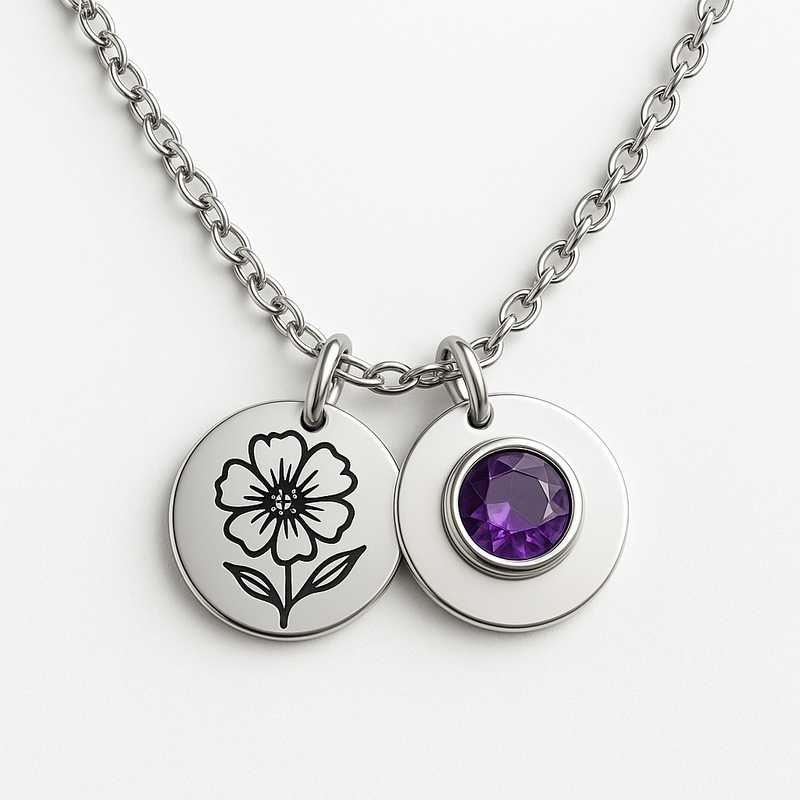Precision Meets Sustainability: Custom Stainless Steel Charm Tech

Explore material advantages, advanced techniques, and green innovations in OEM/ODM birth month flower & birthstone charm necklace manufacturing
In a market increasingly driven by precision and eco-responsibility, stainless steel has emerged as the material of choice for modern jewelry OEMs and ODMs. Particularly in the realm of birth month flower and birthstone charm necklaces, the convergence of high-performance materials and sustainable manufacturing processes is redefining how jewelry is crafted. This page dives deep into the strategic use of 304 and 316L stainless steel, cutting-edge techniques like laser microfabrication, hydraulic forming, and chemical pattern etching, along with next-gen green production methods tailored for B2B clients.
Material Integrity: 304 vs. 316L Stainless Steel in Jewelry Manufacturing
In custom charm jewelry, material selection isn’t just aesthetic—it’s foundational. Two stainless steel grades dominate the industry: 304 and 316L. Both are known for corrosion resistance, but they serve different niches based on their compositional strengths and practical benefits.
304 Stainless Steel: The Versatile Standard
- Composition: Iron, chromium (~18%), nickel (~8%)
- Corrosion Resistance: Excellent for general-use jewelry; resists rust in most environments but may degrade in salt-heavy or high-chloride atmospheres.
- Application: Popular for cost-efficient charms, especially in dry climates or fashion-forward regions with low exposure to moisture.
316L Stainless Steel: The Premium Performer
- Composition: Similar to 304, but with added molybdenum (~2-3%)
- Corrosion Resistance: Superior protection against chlorides, sweat, and skin oils; hypoallergenic and ideal for sensitive skin
- Application: Best for coastal markets, wellness brands, or premium ODM lines seeking lifetime durability and luxury-grade polish
Case Insight: A European ODM partner reported a 30% drop in customer returns after switching from 304 to 316L in a coastal-themed birthstone collection, due to better tarnish resistance and skin compatibility.
Precision Engineering: Technologies That Define the Future of Custom Charms
Beyond material, how your birth month flower and birthstone charms are made sets your brand apart. Advanced manufacturing technologies offer not only unparalleled detail but also scalable efficiency.
Laser Microcutting
This technique enables micron-level floral petal shapes and gemstone seating zones to be cut without deformation. It allows design complexity that was previously impossible with mechanical stamping. Ideal for intricate birth month flowers such as Chrysanthemums (November) or Lily-of-the-Valley (May).
Hydraulic Forming
Used to create ultra-fine 3D curves in stainless steel without cracking, hydraulic forming ensures seamless domes and bezel cups for embedded birthstones. It’s a go-to for achieving organic bloom structures while keeping symmetry intact.
Chemical Etching (Corrosion Patterns)
Corrosion-controlled patterning adds depth without compromising the base material. Popular for crafting flower veins, calligraphic engraving, or astrological motifs directly onto the charm body—especially powerful in niche seasonal collections.
OEM Insight: One North American brand integrated laser-cut Chrysanthemums with acid-etched dew drops on 316L bases, boosting their holiday custom order volume by 42% YOY.
Green Manufacturing: Redefining Sustainability in Charm Production
Eco-conscious B2B buyers are now demanding more than recyclability—they want circularity and transparency. Fortunately, modern charm necklace production has evolved to meet these expectations.
Closed-Loop Waste Recycling
- Metal offcuts from laser processes are collected, remelted, and reintegrated into sheet stock with minimal energy loss.
- Water-based etching solutions are filtered and reused up to 10 cycles before disposal, minimizing ecological impact.
Green Electroplating Technologies
Traditional plating often relies on cyanide and heavy metals. Modern alternatives like trivalent chromium and ionic plasma deposition allow for nickel-free, hypoallergenic finishes with reduced emissions and water usage.
Energy Optimization
LED-lit cleanrooms, solar-powered engraving units, and real-time factory energy monitoring systems contribute to leaner production. OEM clients often highlight these upgrades in ESG reports and retail marketing campaigns.
ODM Highlight: A Japan-based ODM added green plasma-plated birthstone bezel settings to their Q3 release. This not only aligned with sustainability goals but unlocked eligibility for eco-retailer shelf space in Europe.
Practical Applications: Real-World Examples of OEM/ODM Charm Excellence
Translating technology into business value means showing results. Here are sample executions that combine all the above features into commercially viable charm collections:
- OEM Birth Month Line for North America: Used 304 steel laser-cut daisies with etched scroll names and recycled packaging. Focused on volume gifting market with moderate margins.
- ODM Luxe Flower-Birthstone Fusion: 316L rose-gold plasma-plated bases with deep-set natural stones. Paired with custom cards for boutique retail chains across Europe.
- Seasonal “Nature Reclaimed” Campaign: Etched floral mandalas with recycled steel, zero-waste hydraulic forming, and green plating. Sold via online pop-up shops with CO2-neutral fulfillment.
Conclusion: Partner in Precision. Scale with Sustainability.
Whether you’re an established jewelry house expanding your charm collection or a startup brand seeking OEM manufacturing at scale, the fusion of stainless steel performance with sustainable innovation is the new benchmark. By combining 316L and 304 stainless steel strategically, leveraging advanced technologies like laser microcutting and hydraulic forming, and embracing eco-conscious processes, your brand can achieve both design excellence and ESG alignment.
Let’s make meaningful, lasting jewelry—without compromise. Contact us to start your OEM/ODM journey today.
